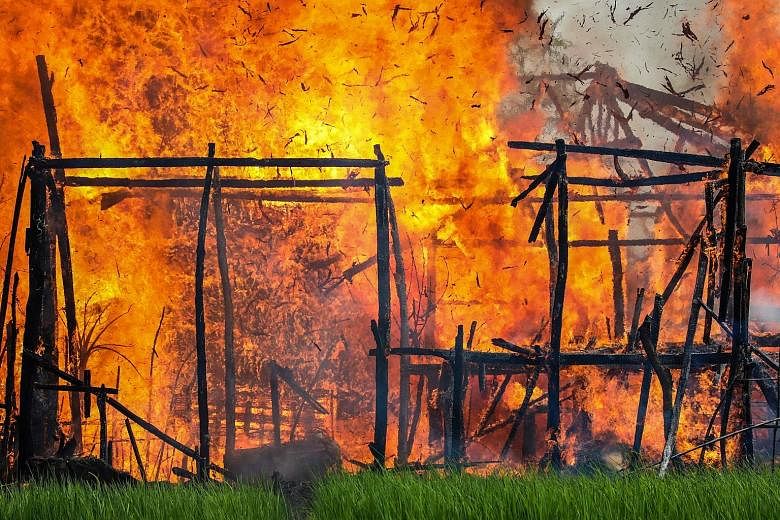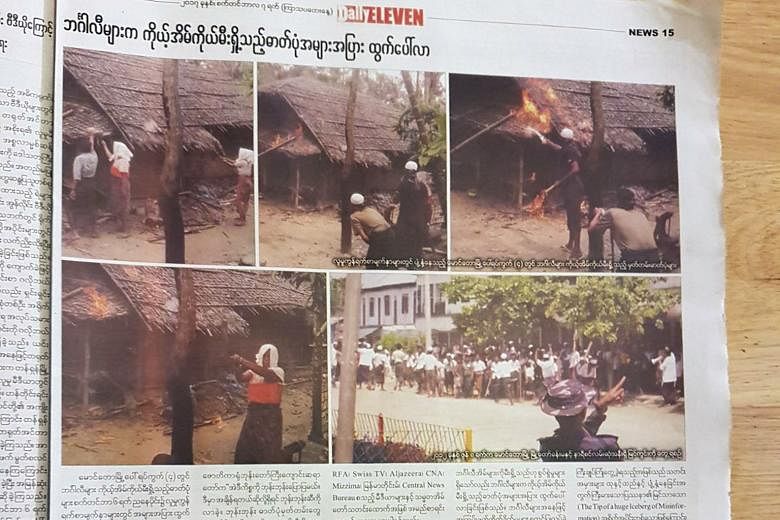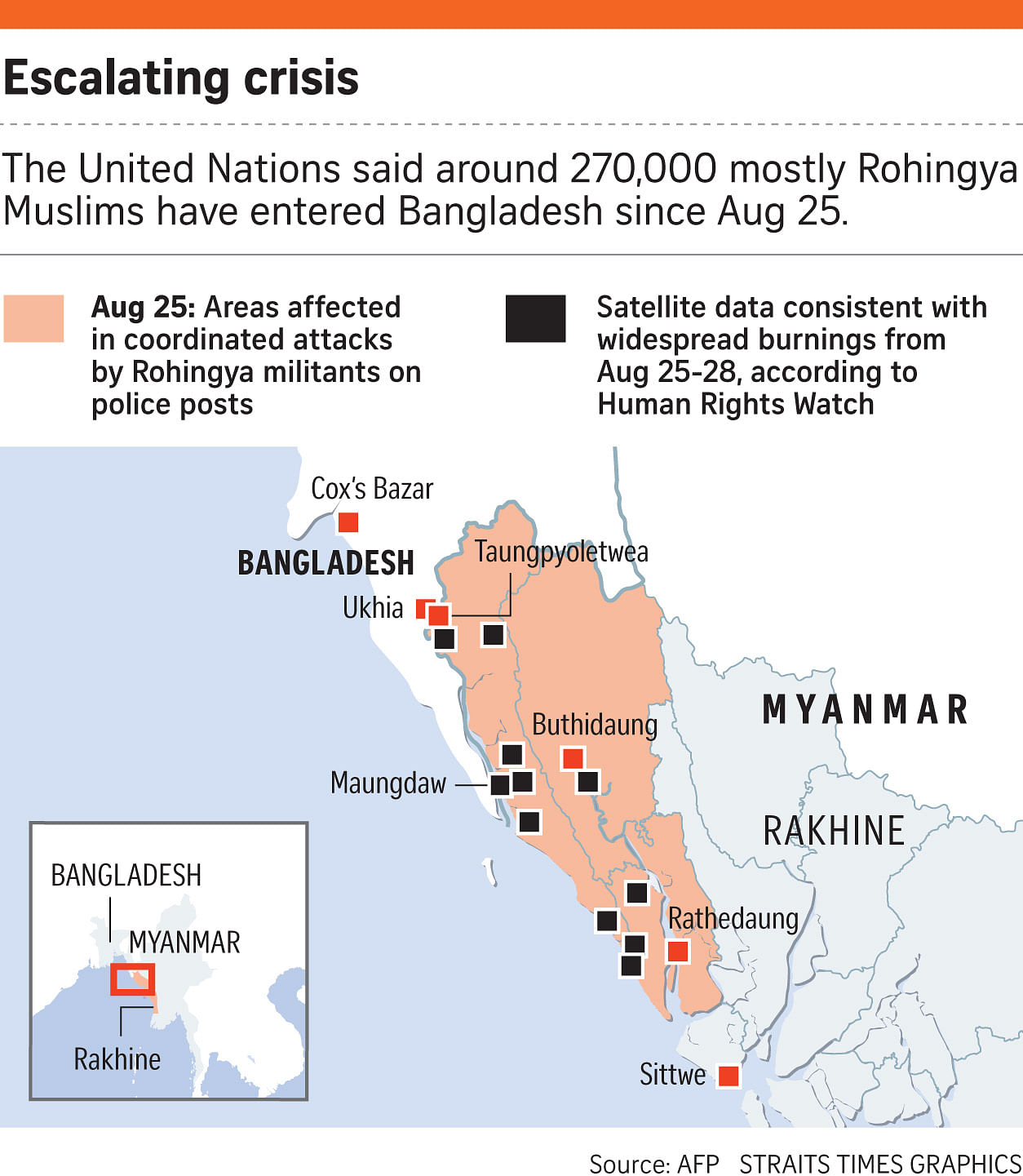No one can say when the photos were taken, but they went viral on Myanmar's social media overnight: A group of men - some wearing Muslim prayer caps - crouching near a straw-roofed house watching it burn after they set it alight.
"Photos of Bengalis torching their houses themselves," declared popular local Eleven Media group on its Facebook post on Wednesday. This was followed by a newspaper report comprising an interview with the monk who purportedly witnessed the arson.
But it did not take long for Internet sleuths to raise questions: Why was one of the men putting on a prayer cap as he watched the house burn? Why did the two women who appeared in some of the photos have their heads covered in scarves that resembled table cloth?
Hours later, an eagle-eyed reader spotted one of the "Bengalis" in a photo published online by another media group, Mizzima. The photo accompanied a story about Hindu families who had fled the recent violence in Rakhine state. The man was wearing the same green plaid shirt.
Mr Zaw Htay, spokesman for Myanmar's de facto leader Aung San Suu Kyi, announced on Thursday that the government was investigating the authenticity of the photos. "Govt (sic) won't accept any fake!" he wrote on Twitter.
But he left on his Twitter feed an earlier entry where he drew attention to the Eleven story, with his own comment: "Photos of Bengalis setting fire to their houses".
It's hard to tease fact from fiction amid polarised sentiments about the insurgency by Rohingya militants that triggered a military counter offensive and wave of refugees. Naypyitaw has not allowed journalists independent access to the part of Rakhine state rocked by the violence.
Human rights groups have fingered security forces - working with armed Rakhines - for the fires in vast swathes of villages vacated by fleeing Rohingya. The government alleges that the Rohingyas - derogatorily called "Bengalis" - are burning their own homes.
While global media attention has focused on the horrific tales of shooting, arson and rape emerging from the 290,000 Muslim Rohingya who have fled from western Myanmar to Bangladesh over the past two weeks, Burmese language media have dwelled more on the threat posed by Arakan Rohingya Salvation Army (Arsa). The militant group has declared war on the Myanmar military on behalf of the disenfranchised Muslim Rohingya minority. Naypyitaw has declared it a terrorist organisation.
About 27,000 Buddhists and Hindus have also been displaced by the violence. Social media has been flooded with graphic images and videos purportedly showing attacks on various groups, usually accompanied by inflammatory language.
"Some people tell me that the international media represents only the Muslim side, not the Rakhine side," Mr Tuntun Linn, a Yangon-based information technology executive, tells The Sunday Times. "But we don't really know what is happening on the ground. Everybody relies on Facebook."
-
Amnesty confirms border landmines planted by Myanmar
-
YANGON • Amnesty International said it had confirmed that Myanmar military used landmines near the border with Bangladesh, after Reuters first reported explosions and what Bangladeshi border guards said were injuries caused by anti-personnel mines.
The organisation said the mines "have seriously injured at least three civilians, including two children, and reportedly killed one man in the past week", citing witnesses and analysis by its weapons experts.
The "authorities must immediately end this abhorrent practice against people who are already fleeing persecution," said Ms Tirana Hassan, Amnesty International's crisis response director.
Bangladesh lodged a protest on Wednesday after it also said Myanmar had laid mines near the border.
A Myanmar military source told Reuters mines were laid along the border in the 1990s to prevent trespassing and the military has since tried to remove them. But none has been planted recently.
The army has not commented on the blasts.
Zaw Htay, the spokesman for Myanmar leader Aung San Suu Kyi, told Reuters on Monday that a clarification was needed to determine where the blasts occurred, who could go near border areas, and who laid the mines.
REUTERS
The recent violence had erupted in the poorest state of Myanmar on top of a thick layer of inter-communal tension. Ethnic Rakhines regard the Rohingyas as interlopers from present-day Bangladesh. Riots between the two groups five years ago displaced over 100,000 people and condemned displaced persons into apartheid-like conditions in camps.
International attention on the plight of the stateless Rohingya - who number about 1 million - has made Rakhines feel insecure about their position in the state.
The first Arsa attack on three border guard posts last October killed nine policemen and triggered a military crackdown that the United Nations says involved Rohingya families being slaughtered and women raped. This the government denies. On Aug 25, Arsa raided 30 police posts and an army base with up to 6,500 fighters, using knives and crude bombs, said a Reuters report.
Myanmar's civilian government, which has no control over the military and is bound by Constitution into a power-sharing arrangement, rebuffed attempts to declare a state of emergency and martial law in Rakhine state before the Aug 25 attack. But it is Ms Suu Kyi who has borne the brunt of international condemnation for the Rohingyas' state.
The locals have chafed at the insults hurled against their mother figure. "She is doing her best for the country," Yangon resident Nay Linn Tun, tells The Sunday Times.
National security adviser Thaung Tun, who has stressed that no ethnic cleansing was taking place, told diplomats last week the country has "every right" to defend itself.
On the ground, news of the Arsa attacks has stirred nationalist feelings. "People are saying 'we will protect our land, we will not surrender even one inch'," Mr Tuntun Linn says.
A Burmese language commentary in The Standard Time Daily on Wednesday said: "We should protect the country from people who are trying to create an issue with human rights, and who are trying to occupy the land. Don't try to water poisonous plants."
On the day the governmentsaid it was probing the authenticity of the house-burning photographs, some journalists were visiting Rakhine on a government-controlled trip. Accompanied by security officers visiting places chosen by the government, they stumbled on a village ablaze and met "a group of young, muscular men carrying machetes, swords and slingshots", wrote BBC journalist Jonathan Head. Off camera, they admitted to being Rakhine Buddhists. "One admitted he had lit the fires, and said he had help from the police," Mr Head wrote.
The Myanmar government plans to strengthen and extend the fencing along its border with Bangladesh. The quarter of a million refugees now crowded into eastern Bangladesh would be allowed to return only if they have "valid proof" of citizenship and residency, Mr Thaung Tun says. With their homes razed, it is not clear if this will be possible.
Mr Nay Linn Tun hopes they never get to return. "We should not accept these people even if they want to come back," he told The Sunday Times. "What if they come back with training from terrorists?"




